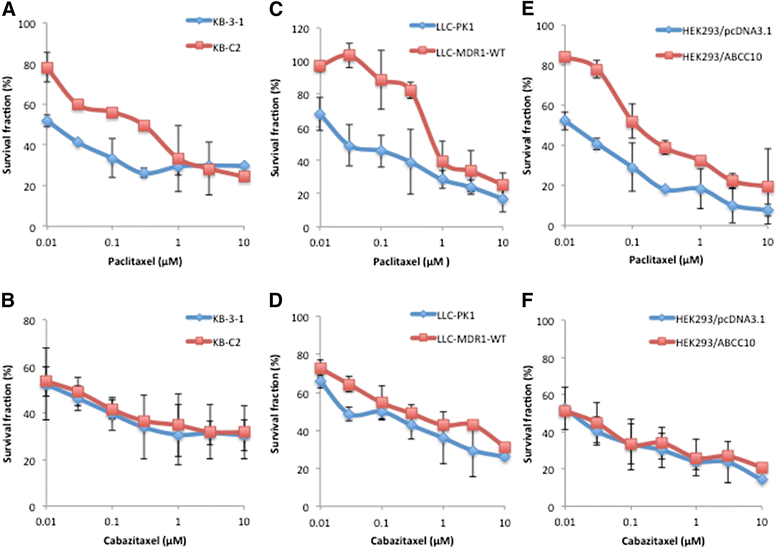ATP-binding cassette subfamily B member 1 (ABCB1) and subfamily C member 10 (ABCC10) are not primary resistance factors for cabazitaxel
- PMID: 25962593
- PMCID: PMC4593353
- DOI: 10.1186/s40880-015-0003-0
ATP-binding cassette subfamily B member 1 (ABCB1) and subfamily C member 10 (ABCC10) are not primary resistance factors for cabazitaxel
Abstract
Introduction: ATP-binding cassette subfamily B member 1 (ABCB1) and subfamily C member 10 (ABCC10) proteins are efflux transporters that couple the energy derived from ATP hydrolysis to the translocation of toxic substances and chemotherapeutic drugs out of cells. Cabazitaxel is a novel taxane that differs from paclitaxel by its lower affinity for ATP-binding cassette (ABC) transporters.
Methods: We determined the effects of cabazitaxel, a novel tubulin-binding taxane, and paclitaxel on paclitaxel-resistant, ABCB1-overexpressing KB-C2 and LLC-MDR1-WT cells and paclitaxel-resistant, ABCC10-overexpressing HEK293/ABCC10 cells by calculating the degree of drug resistance and measuring ATPase activity of the ABCB1 transporter.
Results: Decreased resistance to cabazitaxel compared with paclitaxel was observed in KB-C2, LLC-MDR1-WT, and HEK293/ABCC10 cells. Moreover, cabazitaxel had low efficacy, whereas paclitaxel had high efficacy in stimulating the ATPase activity of ABCB1, indicating a direct interaction of both drugs with the transporter.
Conclusion: ABCB1 and ABCC10 are not primary resistance factors for cabazitaxel compared with paclitaxel, suggesting that cabazitaxel may have a low affinity for these efflux transporters.
Figures


Similar articles
-
Erlotinib (Tarceva, OSI-774) antagonizes ATP-binding cassette subfamily B member 1 and ATP-binding cassette subfamily G member 2-mediated drug resistance.Cancer Res. 2007 Nov 15;67(22):11012-20. doi: 10.1158/0008-5472.CAN-07-2686. Cancer Res. 2007. PMID: 18006847
-
Linsitinib (OSI-906) antagonizes ATP-binding cassette subfamily G member 2 and subfamily C member 10-mediated drug resistance.Int J Biochem Cell Biol. 2014 Jun;51:111-9. doi: 10.1016/j.biocel.2014.03.026. Epub 2014 Apr 12. Int J Biochem Cell Biol. 2014. PMID: 24726739 Free PMC article.
-
The BTK Inhibitor Ibrutinib (PCI-32765) Overcomes Paclitaxel Resistance in ABCB1- and ABCC10-Overexpressing Cells and Tumors.Mol Cancer Ther. 2017 Jun;16(6):1021-1030. doi: 10.1158/1535-7163.MCT-16-0511. Epub 2017 Mar 6. Mol Cancer Ther. 2017. PMID: 28265007 Free PMC article.
-
Recent advances regarding the role of ABC subfamily C member 10 (ABCC10) in the efflux of antitumor drugs.Chin J Cancer. 2014 May;33(5):223-30. doi: 10.5732/cjc.013.10122. Epub 2013 Oct 9. Chin J Cancer. 2014. PMID: 24103790 Free PMC article. Review.
-
Therapeutic strategies to overcome taxane resistance in cancer.Drug Resist Updat. 2021 Mar;55:100754. doi: 10.1016/j.drup.2021.100754. Epub 2021 Feb 27. Drug Resist Updat. 2021. PMID: 33691261 Review.
Cited by
-
Associations of genetic polymorphisms of the transporters organic cation transporter 2 (OCT2), multidrug and toxin extrusion 1 (MATE1), and ATP-binding cassette subfamily C member 2 (ABCC2) with platinum-based chemotherapy response and toxicity in non-small cell lung cancer patients.Chin J Cancer. 2016 Sep 2;35(1):85. doi: 10.1186/s40880-016-0145-8. Chin J Cancer. 2016. PMID: 27590272 Free PMC article.
-
Towards better dose individualisation: metabolic phenotyping to predict cabazitaxel pharmacokinetics in men with prostate cancer.Br J Cancer. 2017 May 9;116(10):1312-1317. doi: 10.1038/bjc.2017.91. Epub 2017 Apr 11. Br J Cancer. 2017. PMID: 28399110 Free PMC article.
-
Cancer nuclear envelope rupture and repair in taxane resistance.Med Rev (2021). 2024 Jun 5;4(6):522-530. doi: 10.1515/mr-2024-0019. eCollection 2024 Dec. Med Rev (2021). 2024. PMID: 39664077 Free PMC article. Review.
-
Influence of AGTR1 and ABCB1 Gene Polymorphism on the Curative Effect of Irbesartan.Int J Hypertens. 2022 Nov 9;2022:4278675. doi: 10.1155/2022/4278675. eCollection 2022. Int J Hypertens. 2022. PMID: 36404948 Free PMC article.
-
Novel delivery approaches for cancer therapeutics.J Control Release. 2015 Dec 10;219:248-268. doi: 10.1016/j.jconrel.2015.09.067. Epub 2015 Oct 9. J Control Release. 2015. PMID: 26456750 Free PMC article. Review.
References
-
- Dumontet C, Sikic BI. Mechanisms of action of and resistance to antitubulin agents: microtubule dynamics, drug transport, and cell death. J Clin Oncol. 1999;17:1061–70. - PubMed
Publication types
MeSH terms
Substances
Grants and funding
LinkOut - more resources
Full Text Sources
Other Literature Sources
Miscellaneous

